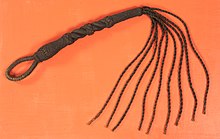Cat o' nine tails
O Cat o' nine tails (em português: gato de nove caudas, comumente abreviado para o gato), é um tipo de chicote ou mangual de várias caudas que se originou como um instrumento para punição física severa, principalmente na Marinha Real e no Exército Britânico, e como punição judicial na Grã-Bretanha e alguns outros países.[1][2][3][4][5]


Ver também
editarReferências
- ↑ Martin, Randall (2006). «'The cat' Gets its Nine tails». Notes and Queries. 53 (1): 31–34. doi:10.1093/notesj/gjj118
- ↑ William Congreve's love for love and first mention of cat o nine tails see page 32 and the fourth dialogue down spoken by Ben.
- ↑ Cooper, W. M. (1869). Flagellation and the Flagellants: A History of the Rod in all Countries from the earliest Period to the present Time. London: John Camden Hotten. p. 369
- ↑ Country Reports on Human Rights Practices, Egypt: 2001, U.S. State Department.
- ↑ Lavery, Brian (1989). Nelson's Navy: The Ships, Men and Organisation 1793-1815. [S.l.]: Naval Institute Press. p. 218. ISBN 9781591146124
Ligações externas
editar- William Congreve's Love for Love and the first mention of cat of nine tails in literature see page 32 and the fourth dialogue down spoken by Ben
- CORporalPUNishment website – here an illustrated example among many other articles, mainly on the adult cat
- EtymologyOnLine
- Joseph W. Bean, Flogging, Greenery Press, 2000. ISBN 1-890159-27-1.
- Inter-American Court of Human Rights orders Trinidad to pay compensation for flogging and humiliation of prisoners in March 2005
- Amnesty International report on use of the Cat o' nine tails on 6 Oct. 2006 in Bahamas
- Amnesty International report recording use of Cat o' nine tails on woman and young boy in Trinidad
- Inter-American Court of Human Rights' decisions and documents